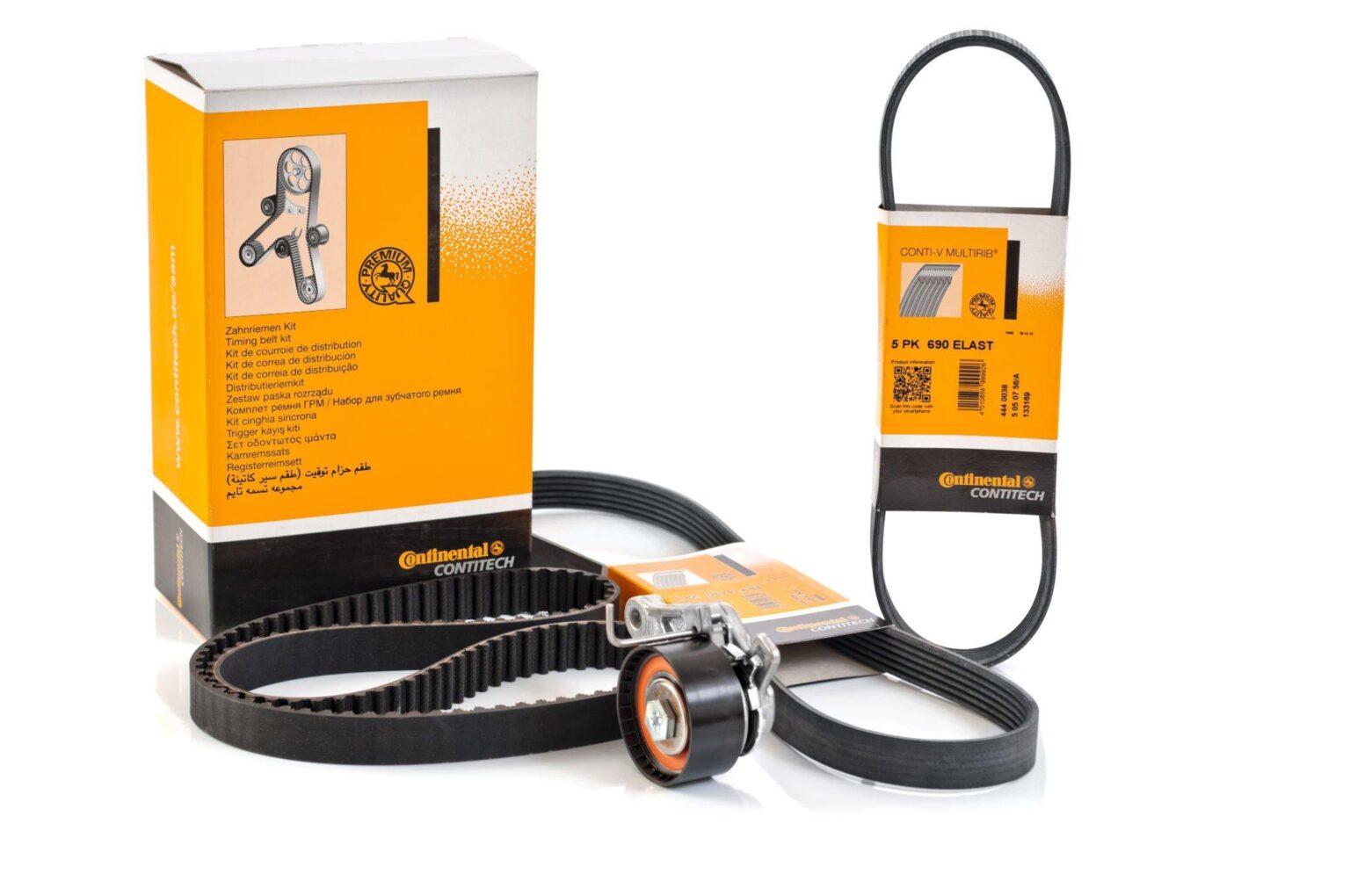A timing belt is one of the most important parts of a car that makes the camshafts and the crankshafts work in collaboration, ultimately keeping the engine running. The crankshaft moves the pistons, which in turn help the power and intake cycles, whereas the camshaft takes care of the valves that allow fuel entry. A timing belt allows both to work in sync with each other. As it precisely times the opening and closing of the valves with the help of the pistons, the name is apt – timing belt. It also runs the oil pump, water pump, and injection pump. However, not all cars have a timing belt; some might see a comeback of the timing chain, which was used till the early 80s.
Many timing belts are made of synthetic rubber. For better strength and to reduce stretching, nylon and fibreglass are added. But new cars use chains instead of belts as they are more durable.
What Is a Timing Belt on a Car?
A timing belt, also known as a cambelt in some countries, is a reinforced rubber belt that keeps the crankshaft and camshaft turning in proper time with each other. This ensures that the engine valves open and close at the right time during each cylinder’s intake and exhaust strokes. Without a properly functioning car timing belt, combustion would not occur efficiently, and engine damage could follow.
The timing belt typically operates inside a protective cover to keep debris and contaminants away. If your vehicle still uses a belt rather than a chain, it is essential to follow manufacturer’s guidelines on when to change it.
Timing Belt vs. Serpentine Belt: What’s the Difference?
It is easy to get confused between a timing belt and a serpentine belt. There are some similarities, but they are not the same. If a serpentine belt breaks down, it won’t affect the core function of your engine—it may disable the air conditioner, alternator, or power steering. However, if the timing belt breaks, it can cause serious internal engine damage.
A serpentine belt is generally easier and cheaper to replace, while a timing belt replacement is more complex and requires more disassembly. This is why proper care and timely timing belt replacement are crucial.
When to Replace the Timing Belt
Timing Belt Change Intervals by Vehicle Type
Every manufacturer has different maintenance schedules, but the average recommendation for timing belt change is between 60,000 and 100,000 miles. Some vehicles may require earlier replacement depending on engine design and driving conditions. Always consult your owner’s manual.
Why Replace the Timing Belt?
Unfortunately, there are no particular signs that indicate the wearing out of the timing belt. However, your car might show some symptoms:
- Loss of power
- Poor fuel economy
- Misfiring and engine vibration
- Maybe timing belt noise
- The belt tensioner may fail
- A pulley may wear out
Moreover, when the timing belt starts to peel off, shows cracks, is softening or hardening, or has oil or water contamination, it is time to replace the belt.
If you wish to check the condition of your belt, press your fingernail against its back. If the impression is embossed, your belt can work for a little time. But if the belt has hardened, it will not allow the impression to be seen. Replacement is required immediately. Do not wait for the belt to break.
What Happens If You Don’t Replace the Timing Belt?
When a timing belt of an interference engine breaks, it causes damage to the valves and piston, which might have gravely mutilated the engine. On the other hand, with a non-interference engine, a broken timing belt shuts down the engine completely. Without replacing it, the car won’t start.
In many cases, people ignore the belt until it breaks. This can result in serious internal engine damage that may be expensive to fix. A new belt is far cheaper than replacing bent valves or rebuilding an engine.
If your car has a chain instead of a belt, replacement is not required unless very necessary, as the latter is a maintenance-free unit.
How to Replace a Timing Belt?
If you have the right tools and skills, replacing a timing belt isn’t a difficult task. The harder parts could be the removal of the main engine pulley and setting the accurate timing, along with the new belt adjustment. The car manual has all the details that can help you in the replacement process.
Tools Required
- Belt tension gauge
- Tensioner pulley and adjuster
- Pulley tool handle
Once you have the tools and the repair manual, you are ready for the work.
Timing Belt Removal Process
The first step is to remove the timing belt:
- Disconnect and keep away the negative battery cable
- Remove the alternator belt
- Remove the timing belt cover after taking off the accessory belts, hoses, or any other components covering it (Some cars may not have a belt cover)
- You might also have to remove the cooling fan, power steering, or alternator
- When the cover is removed, check the sensors, accessories, or wires
- Align the timing marks visible on the camshaft and crankshaft sprockets
- The belt tensioner pulley will have the adjustment bolt – Slowly, loosen it or remove it if required
- Remove the bolts or screws which hold the timing cover
- Now, remove the belt from the crankshaft sprocket
- Remove the crankshaft pulley
- Now, remove the timing belt from the vehicle
Installing the New Timing Belt
Alignment of the crankshaft and camshaft is very important when you install the timing belt. Check if the new belt is of the same length and width, and has the same tooth configuration as the old one.
- Position the belt around the crankshaft sprocket
- Install the crankshaft pulley
- Align the crankshaft sprocket and pulley with the marks on the engine
- Align the camshaft sprocket and the cylinder head
- Thread the timing belt around the camshaft sprocket
- Move the tensioner to the belt to apply pressure
- Set proper tension
- Reinstall the sensors or brackets you might have removed
- Reinstall the timing belt cover
- Reinstall the accessories you removed
- Connect the negative battery cable to the battery
- Start the engine to check if the belt is working
How Hard Is It to Replace a Timing Belt?
Replacing a timing belt isn’t the easiest DIY task—it requires precision, patience, and a solid understanding of your engine. While it’s technically a bolt-on job, aligning the timing marks correctly is absolutely critical. Even a slight misstep can cause serious engine damage.
That said, the job is moderately difficult, not impossible. If you have the right tools, mechanical know-how, and confidence, you can tackle a timing belt replacement yourself. Just be prepared to spend a few focused hours on it.
If you’re unsure or not ready to take the risk, it’s best to leave it to the professionals. Don’t wait for your engine to fail unexpectedly. Regularly inspect the belt and replace it at the recommended interval to avoid costly breakdowns.
FAQs
1. How long does it take to change a timing belt?
Professionals may take 3–6 hours to change the belt, depending on the vehicle. DIYers may need more time.
2. How much does it cost to replace a timing belt?
The cost of replacing a timing belt depends on the car brand and engine type. On average, it can range from a few thousand to over ten thousand rupees. This includes the cost of the belt and labour charges. If related parts like the water pump or belt tensioners are also replaced, the final bill can go up accordingly.
3. Where is the timing belt located?
It’s typically behind a cover at the front of the engine, connected between the crankshaft and camshaft.
4. Can I replace a timing belt myself?
Yes, but only if you have moderate-to-advanced mechanical skills and the proper tools.
5. Is a timing belt the same as a drive belt?
No. A drive belt (serpentine belt) powers accessories like the A/C and alternator. A timing belt manages the synchronisation of the engine internals.
6. When to Leave Timing Belt Replacement to the Experts?
If you’re unsure about timing alignment or don’t have access to the necessary tools, it’s best to get a mechanic to do the job. Improper installation could result in thousands of rupees in engine repairs. It’s simply not worth the risk if you’re not confident.
7. Is a Timing Belt the Same as a Cambelt?
Yes, they are. The term “cambelt” is primarily used in the UK, while “timing belt” is more common in North America. Both refer to the same part.
Stay Ahead of Breakdowns – Replace Your Timing Belt on Time!
At Krishna Auto Electric, we supply high-quality timing belts for a wide range of vehicles. Whether you’re a DIY enthusiast or a professional mechanic, we have the products and expert advice you need.
Call us at +91 9825063530 or fill out our online inquiry form to learn more about our automotive spare parts.

